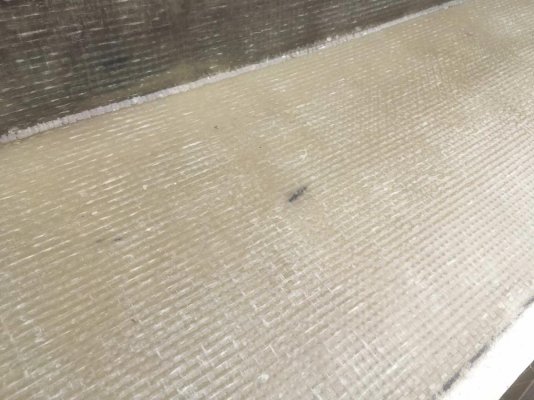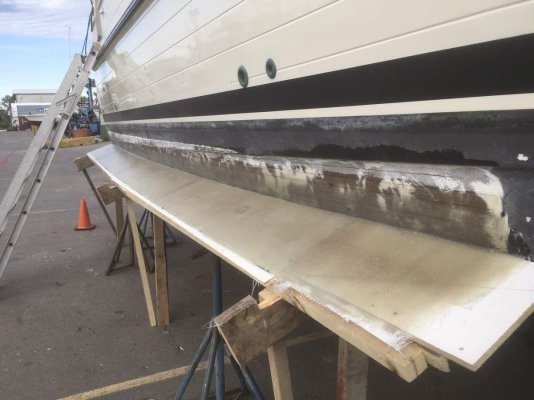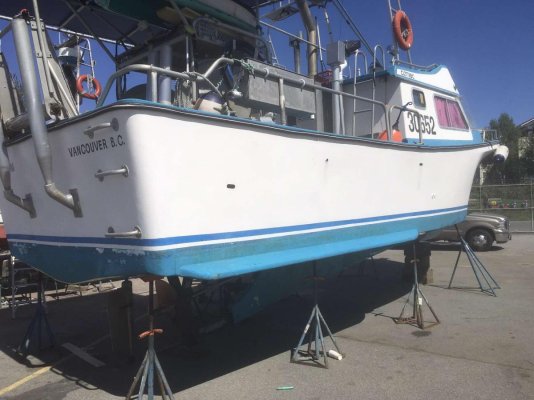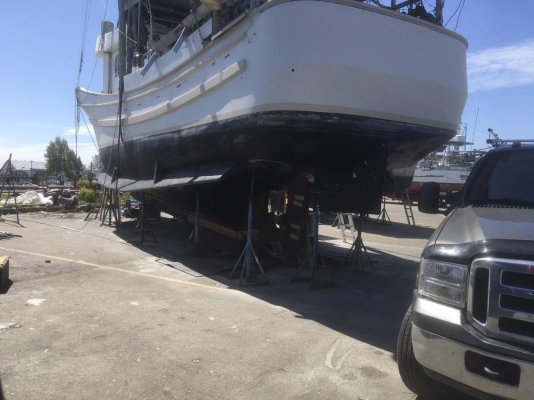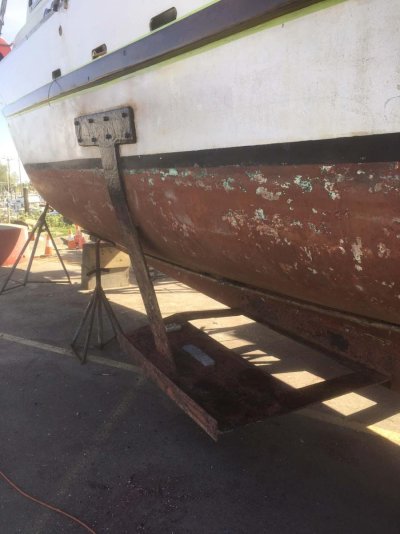You are using an out of date browser. It may not display this or other websites correctly.
You should upgrade or use an alternative browser.
You should upgrade or use an alternative browser.
North Pacific Trawler 39 getting rolling chocks
- Thread starter JDCAVE
- Start date
The friendliest place on the web for anyone who enjoys boating.
If you have answers, please help by responding to the unanswered posts.
If you have answers, please help by responding to the unanswered posts.
The debate continues. I've read numerous technical papers on roll reduction and the general consensus is less than 10% roll reduction. However the shipyard's naval architect whom I asked swore a solid 30% effectiveness.
I think it depends on how they are built. Here are two examples. The first is from a boatyard in India I visited and the chock design appears to me to be just about worthless. I doubt they would even yield a few percent.
The second photo is a different shipbuilder, chocks being fitted to a new build, and even just eye-balling it you can tell these will be much more effective.
Both of those are tiny, by comparison to the ones being installed in BC, which are perhaps 4x the size proportionally or more. This is why I say one must be specific in the description. Mine run 2/3 of the waterline length, and are something like 7% of the WL beam wide, each.
The majority of the ones installed in BC are on commercial fishing boats, people who do not spend money frivolously and who talk to each other. So either they believe they work, or there is mass hysteria on Van Isle.
MurrayM
Guru
I’ll stay out of the debate but there seems to be sufficient history of the practice in coastal British Columbia that fisherman continue with putting them on both hard and soft chine vessels.
Jim
Interested to see how much is trimmed off and what the final shape will be.
Thanks for keeping an eye on it for us!
Lou_tribal
Guru
I find this very interesting.
One concern though, looking at their placement can’t this interfere while docking?
L
One concern though, looking at their placement can’t this interfere while docking?
L
Nomad Willy
Guru
DDW wrote;
“The majority of the ones installed in BC are on commercial fishing boats, people who do not spend money frivolously and who talk to each other.”
Indeed they are but at times they think in terms of commercial fishing that is not very similar in many ways to pleasure boating. Most fishermen in SE Alaska have anchors 75% of pleasure boaters would be ashamed to have on their bows. And rodes that may push a pleasure boat 6” down in the water. But they anchor differently. One said to me “Eric we don’t have time for all that stuff”. They usually anchor in the same spot, dump the rode (anchor and then the rode in one spot) and make it fast on deck. Very seldom back down and set. Their anchors don’t hold well but they set very dependably. The rode is usually vertical all night and often w studded chain.
In the early days w wood boats they’d pay their seams w concrete.
I’m guessing they employ chine chocks to reduce rolling just enough to keep fishing. In a seastate that would have most here scream’in for big active stabilizers. As long as they can hire somebody to go out on deck and do the work .... it’s all about the bottom line.
“The majority of the ones installed in BC are on commercial fishing boats, people who do not spend money frivolously and who talk to each other.”
Indeed they are but at times they think in terms of commercial fishing that is not very similar in many ways to pleasure boating. Most fishermen in SE Alaska have anchors 75% of pleasure boaters would be ashamed to have on their bows. And rodes that may push a pleasure boat 6” down in the water. But they anchor differently. One said to me “Eric we don’t have time for all that stuff”. They usually anchor in the same spot, dump the rode (anchor and then the rode in one spot) and make it fast on deck. Very seldom back down and set. Their anchors don’t hold well but they set very dependably. The rode is usually vertical all night and often w studded chain.
In the early days w wood boats they’d pay their seams w concrete.
I’m guessing they employ chine chocks to reduce rolling just enough to keep fishing. In a seastate that would have most here scream’in for big active stabilizers. As long as they can hire somebody to go out on deck and do the work .... it’s all about the bottom line.
DDW do you have photos of your installation or those of the fishermen you refer to?
They bisect the chine angle. They do not extend past the rub rail, so I assume no problem with docking.



I’m guessing ....
There are many guesses in these threads, and about 6 or 7 owners on the forum who actually have the sort I am talking about. Every one of those says they work and are well worth it. I'd love to hear from someone who put them on and either doesn't like them, thought they wasted their money, or had them taken off. That would be some information of interest.
They are not expensive in yacht terms, and will not be the most expensive experiment I have tried by far. Active stabilizers are expensive, damage prone, power hungry, and impractical on a small trawler. That makes these the only alternative. Or live with the snap roll.
Nomad Willy
Guru
And these...are bat wings on a small northern troller. The fisherman doesn’t like them but they came with the boat. They pick up kelp.
View attachment 88390
JDCAVE,
Looks like that boat actually did need the Bat Wings.
Can you imagine how that boat would roll w/o them?
If he takes them off see if you can get it take on that.
These are Bilge Keels!
https://www.boattrader.com/listing/...dynamic+re&utm_content=dynamic+retargeting+us
See the 4th photo in the listing.
https://www.boattrader.com/listing/...dynamic+re&utm_content=dynamic+retargeting+us
See the 4th photo in the listing.
Nomad Willy
Guru
DDW,
HaHa I’m usually the experimenter.
But show me a new boat that has bilge keels/chine chocks or whatever designed by a NA. I’ve seen some strange things by NA’s lately. I’ve never heard of a capsize caused by these things and I think the only reason I haven’t is because it just hasn’t come up in the sea of information out there.
They really are very much like a keel. Only a foot below the WL. Keels don’t seem to cause rollovers .. that I know of. In a knock down they may increase the severity of it or limit it to a knock down avoiding a capsize. Don’t know or know anybody that does.
But if bilge chocks positively don’t cause or aggravate a capsize I’d (whaduya call it) Shut the F up?
Otherwise any downside would seem trivial. Like burning more fuel or fighting w fenders or floats. Small potatoes. But if it’s only 10%?
Keith/koliver,
Indeed they are. And I’ll bet they do more than 10% too. They look like they need a side strut as a brace though. And that would surely dent efficiency. But being vertical they prolly aren’t as effective as their sq. footage would indicate.
HaHa I’m usually the experimenter.
But show me a new boat that has bilge keels/chine chocks or whatever designed by a NA. I’ve seen some strange things by NA’s lately. I’ve never heard of a capsize caused by these things and I think the only reason I haven’t is because it just hasn’t come up in the sea of information out there.
They really are very much like a keel. Only a foot below the WL. Keels don’t seem to cause rollovers .. that I know of. In a knock down they may increase the severity of it or limit it to a knock down avoiding a capsize. Don’t know or know anybody that does.
But if bilge chocks positively don’t cause or aggravate a capsize I’d (whaduya call it) Shut the F up?
Otherwise any downside would seem trivial. Like burning more fuel or fighting w fenders or floats. Small potatoes. But if it’s only 10%?
Keith/koliver,
Indeed they are. And I’ll bet they do more than 10% too. They look like they need a side strut as a brace though. And that would surely dent efficiency. But being vertical they prolly aren’t as effective as their sq. footage would indicate.
Last edited:
Nomad, the thing about NAs is that boat design, and particularly yacht design, is an incredibly slow moving and conservative field. No NA want's to break the mold, those that do and fail usually end their careers. This is why for example in sailboat design it takes about 100 years for a good idea to become popular. Not an exaggeration - 100 years.
A problem with rolling chocks for a production builder are, they cannot be easily molded in standard female hull molds. They'd need to be added, then faired, then painted.
Now I have no first hand knowledge (yet) but testimonials suggest they do work. Of course testimonials are unreliable.
I believe there is a possibility of contributing to rollover: unlike a keel which tends to lift out and release as the boat heels in a broach, the chock would dig in. Capsized due to being broadside to a breaking wave are a different physic, and many tests have shown that hull form has little to do with it. Statistically you are probably more likely to be hit by lightening than die in a boat capsize - especially an inshore or close coastal cruiser like mine - so I'm not losing sleep over that worry.
A problem with rolling chocks for a production builder are, they cannot be easily molded in standard female hull molds. They'd need to be added, then faired, then painted.
Now I have no first hand knowledge (yet) but testimonials suggest they do work. Of course testimonials are unreliable.
I believe there is a possibility of contributing to rollover: unlike a keel which tends to lift out and release as the boat heels in a broach, the chock would dig in. Capsized due to being broadside to a breaking wave are a different physic, and many tests have shown that hull form has little to do with it. Statistically you are probably more likely to be hit by lightening than die in a boat capsize - especially an inshore or close coastal cruiser like mine - so I'm not losing sleep over that worry.
bogranjac1
Senior Member
DDW,
HaHa I’m usually the experimenter.
But show me a new boat that has bilge keels/chine chocks or whatever designed by a NA. I’ve seen some strange things by NA’s lately. I’ve never heard of a capsize caused by these things and I think the only reason I haven’t is because it just hasn’t come up in the sea of information out there.
They really are very much like a keel. Only a foot below the WL. Keels don’t seem to cause rollovers .. that I know of. In a knock down they may increase the severity of it or limit it to a knock down avoiding a capsize. Don’t know or know anybody that does.
But if bilge chocks positively don’t cause or aggravate a capsize I’d (whaduya call it) Shut the F up?
Otherwise any downside would seem trivial. Like burning more fuel or fighting w fenders or floats. Small potatoes. But if it’s only 10%?
Keith/koliver,
Indeed they are. And I’ll bet they do more than 10% too. They look like they need a side strut as a brace though. And that would surely dent efficiency. But being vertical they prolly aren’t as effective as their sq. footage would indicate.
" BILGE CHOCKS " LOL


 LOL
LOLNow you just gotta love this guy !! As if there's not enough conjecture over terminology in this pedantic age, the 'Oracle of Delphi' has invented a completely new word. I hope the Oxford Dictionary has been notified.
Last edited:
Nomad Willy
Guru
Word smith eh?
You knew what I was talking about didn’t you?
I knew it was different when I typed it. There’s another if you like.
You’re posts are beginning to sound like FB lines or even political.
How-a-bout we just talk about boats?
You knew what I was talking about didn’t you?
I knew it was different when I typed it. There’s another if you like.
You’re posts are beginning to sound like FB lines or even political.
How-a-bout we just talk about boats?
bogranjac1
Senior Member
nomad willy appreciation
Nothing but the upmost respect for you and your wealth of knowledge .
I did just wander off into a lighter moment....
regards
Brett
Nothing but the upmost respect for you and your wealth of knowledge .

I did just wander off into a lighter moment....
regards
Brett
Last edited:
Nomad Willy
Guru
bogranjac1,
Perhaps I just took it wrong.
And we’ve just told Direct TV / AT&T to take a hike. That means I spend more time on TF but more significantly FaceBook. Lately FB has been a combat every day experience. Too too many can’t have a productive or interesting conversation w/o getting real crude and acidic.
I should have thought more before I posted back to you.
Sorry
Perhaps I just took it wrong.
And we’ve just told Direct TV / AT&T to take a hike. That means I spend more time on TF but more significantly FaceBook. Lately FB has been a combat every day experience. Too too many can’t have a productive or interesting conversation w/o getting real crude and acidic.
I should have thought more before I posted back to you.
Sorry
RT Firefly
Enigma
Greetings,
"That means I spend more time on TF..." Forewarned is forearmed. Thanks...

"That means I spend more time on TF..." Forewarned is forearmed. Thanks...

Nomad Willy
Guru
Nomad, the thing about NAs is that boat design, and particularly yacht design, is an incredibly slow moving and conservative field. No NA want's to break the mold, those that do and fail usually end their careers. This is why for example in sailboat design it takes about 100 years for a good idea to become popular. Not an exaggeration - 100 years.
A problem with rolling chocks for a production builder are, they cannot be easily molded in standard female hull molds. They'd need to be added, then faired, then painted.
Now I have no first hand knowledge (yet) but testimonials suggest they do work. Of course testimonials are unreliable.
I believe there is a possibility of contributing to rollover: unlike a keel which tends to lift out and release as the boat heels in a broach, the chock would dig in. Capsized due to being broadside to a breaking wave are a different physic, and many tests have shown that hull form has little to do with it. Statistically you are probably more likely to be hit by lightening than die in a boat capsize - especially an inshore or close coastal cruiser like mine - so I'm not losing sleep over that worry.
Now DDW,
HaHa yes I can feel the mindful stress of the first (if there ever will be one) NA that goes this route.
The hull molds is a good point .. hadn’t thought of that.
Just had a thought. If one had a two chine hull the bilge keels could be mounted at the lower chine and extend a tad less that 45 degrees. One could assume a skipper may deploy fenders of sufficient size to keep the ends of the bilge keels from contacting pilings or floats. Also commercial fishermen almost universally use the big round ball like fenders that would almost guarantee separation.
Anyway there’s lots that can evolve in this relatively new practice of more bilge keel usage. About 10 years ago there was a Willard 30 that installed bilge keels of significant size.
Speaking of size, that probably accounts for the wide range of effectiveness reported. Some of the bigger bilge keels I’ve seen should definitely reduce roll more than 10% .. maybe 20% or a bit more.
Nomad Willy
Guru
Greetings,
"That means I spend more time on TF..." Forewarned is forearmed. Thanks...

HaHa didn’t mean that as a threat.

dhays
Guru
- Joined
- May 26, 2015
- Messages
- 9,575
- Location
- Gig Harbor, WA
- Vessel Name
- Kinship
- Vessel Make
- 2010 North Pacific 43
There have been a number of North Pacific owners in WA and BC that have installed rolling chocks on their boats. Not a huge number, but a growing number. North Pacific Yachts actually is not adverse to the idea at all. I've spoken to the owner of NPY and he feels they do suppress roll without significantly hurting performance. He is glad to help hook up North Pacific owners with experienced yards in BC that have installed them.
So, while a far cry from a Naval Architect doing design and testing, I think it is significant than the builder isn't concerned about them being installed on their boats.
So, while a far cry from a Naval Architect doing design and testing, I think it is significant than the builder isn't concerned about them being installed on their boats.
"reduce roll" - therein lies one of the problems with quantifying the result. Is it angle, speed, frequency, or acceleration that is important? How much of each is too much? There is a little bit of experimental data on this in the research on motion sickness, but hard to relate it to a small powerboat.
My initial measurements I believe were accurate but disappointing, the roll depth was small. If I measured 10 degrees before, and could duplicate those conditions exactly and got 8, is that 20% a significant difference in comfort? Would I even notice 10%? If the roll depth was the same but the acceleration less would that be even better? I don't know the answers and there does not seem to be a large body of knowledge out there.
That's why I began to think a side-by-side comparison is the only way. Ideally a sistership similarly loaded, go out in some rolly conditions, measure and subjectively characterize, then crew switches boats and do it again. The data could be time corollated for identical conditions. Double blind would be even better, but if the open trial doesn't yield an obvious result then the effect is likely too small to be worth it. I know a few people with identical sisterships and intend to do this.
I don't think there will be any problem at all docking with these. Just an average fender will keep them off, most docks have floats that are inset anyway.
My initial measurements I believe were accurate but disappointing, the roll depth was small. If I measured 10 degrees before, and could duplicate those conditions exactly and got 8, is that 20% a significant difference in comfort? Would I even notice 10%? If the roll depth was the same but the acceleration less would that be even better? I don't know the answers and there does not seem to be a large body of knowledge out there.
That's why I began to think a side-by-side comparison is the only way. Ideally a sistership similarly loaded, go out in some rolly conditions, measure and subjectively characterize, then crew switches boats and do it again. The data could be time corollated for identical conditions. Double blind would be even better, but if the open trial doesn't yield an obvious result then the effect is likely too small to be worth it. I know a few people with identical sisterships and intend to do this.
I don't think there will be any problem at all docking with these. Just an average fender will keep them off, most docks have floats that are inset anyway.
JDCAVE
Guru
- Joined
- Apr 3, 2011
- Messages
- 3,010
- Location
- Canada
- Vessel Name
- Phoenix Hunter
- Vessel Make
- Kadey Krogen 42 (1985)
The work continues. The installer has several jobs going at once, and he explained to me that he can’t do the work in the sun. He’s often working until 8:30-9:00 pm here. I know. I’m sleeping in the boat beside this one!
He’s got on 6 layers of glass mat and the whole layup is >0.5”, perhaps almost 0.625”. He’s putting on the foam edges now.
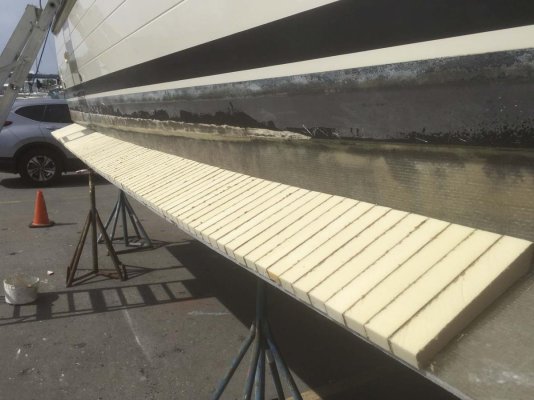
Jim
He’s got on 6 layers of glass mat and the whole layup is >0.5”, perhaps almost 0.625”. He’s putting on the foam edges now.

Jim
Comodave
Moderator Emeritus
- Joined
- Jul 2, 2015
- Messages
- 22,513
- Location
- Au Gres, MI
- Vessel Name
- Black Dog
- Vessel Make
- Formula 41PC
Thanks for the update.
Nomad Willy
Guru
Sounds heavy JD
Ballast chocks?
Ballast chocks?
Sea Word
Senior Member
Great discussion. Regarding hull molding, I don’t see why it would make a huge difference in mold releasing, it may require a multi piece mold but that’s not hard. Regarding dock bashing, I don’t see why they need to be so far out from the chine?
They seem like an exceedingly good idea to me, and as we have a no-keel aluminum boat, I’m definitely thinking about fitting some on my bottom. I’d have an issue of strength however, and bracing them with struts presents issues, so I’ll have to think about that. I may need to make them in two pieces and bend them together at the tips, sort of like canoes welded on bottom.
The picture of the boat beached resting on its two wings is very appealing to me. I love the idea of a tide safe boat where you can beach it, work on it while tide out and then wait for water to come back. So cool.
They seem like an exceedingly good idea to me, and as we have a no-keel aluminum boat, I’m definitely thinking about fitting some on my bottom. I’d have an issue of strength however, and bracing them with struts presents issues, so I’ll have to think about that. I may need to make them in two pieces and bend them together at the tips, sort of like canoes welded on bottom.
The picture of the boat beached resting on its two wings is very appealing to me. I love the idea of a tide safe boat where you can beach it, work on it while tide out and then wait for water to come back. So cool.
Similar threads
- Replies
- 45
- Views
- 10K
- Replies
- 4
- Views
- 2K
- Locked
- Replies
- 2
- Views
- 4K
Latest posts
-
-
-
Just for fun, how many spare hose clamps do you have onboard?
- Latest: BenSmith1982
-
-
-
-
-
-
-

